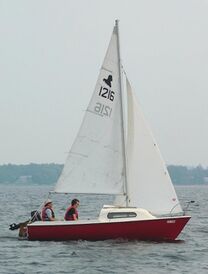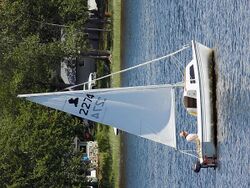Engineering:Siren 17
 | |
| Development | |
|---|---|
| Designer | Hubert Vandestadt |
| Location | Canada |
| Year | 1974 |
| No. built | 3200 |
| Builder(s) | Vandestadt & McGruer Ltd |
| Boat | |
| Boat weight | 750 lb (340 kg) |
| Hull | |
| Type | Monohull |
| Construction | Fibreglass |
| LOA | 17.17 ft (5.23 m) |
| LWL | 15.00 ft (4.57 m) |
| Beam | 6.67 ft (2.03 m) |
| Hull draft | 4.25 ft (1.30 m) with centreboard down |
| Engine type | Outboard motor |
| Hull appendages | |
| Keel/board type | fin keel |
| Ballast | 130 lb (59 kg) |
| Rudder(s) | transom-mounted rudder |
| Rig | |
| General | Fractional rigged sloop |
| I (foretriangle height) | 17.00 ft (5.18 m) |
| J (foretriangle base) | 6.00 ft (1.83 m) |
| P (mainsail luff) | 22.00 ft (6.71 m) |
| E (mainsail foot) | 8.00 ft (2.44 m) |
| Sails | |
| Mainsail area | 88.00 sq ft (8.175 m2) |
| Jib/genoa area | 51.00 sq ft (4.738 m2) |
| Total sail area | 139.00 sq ft (12.914 m2) |
The Siren 17 is a Canadian trailerable sailboat, that was designed by Hubert Vandestadt as trailer sailer and first built in 1974.[1][2][3][4][5]
Production
The boat was built by Vandestadt & McGruer Ltd in Owen Sound, Ontario, Canada , between 1974 and 1987, but it is now out of production.[1][5]
The Siren 17 was one of the most successful small sailboats ever built and 3200 were completed during its 13-year production run.[1]
Design

The Siren 17 is a small recreational keelboat, built predominantly of fibreglass and foam flotation, with mahogany wood trim. It has a fractional sloop rig, with a hinged mast step and jiffy-reefing, a transom-hung rudder and a retractable centreboard keel. The cockpit is self-bailing and 7 ft (2.1 m) long. It displaces 750 lb (340 kg) and carries 130 lb (59 kg) of iron ballast. It has foam flotation for positive buoyancy.[1][2][4][5]
The boat has a draft of 4.25 ft (1.30 m) with the centreboard extended and 0.67 ft (0.20 m) with it retracted, allowing beaching or ground transportation on a trailer.[1][5]
The boat is normally fitted with a small outboard motor of up to 7 hp (5 kW) for manoeuvring. It has a hull speed of 5.19 kn (9.61 km/h).[1][2][4][5]
The design has sleeping accommodation for four people, including two adults. The galley is equipped with a moulded-in icebox, with an alcohol stove optional. The head is a portable type. Cabin headroom is 44 in (112 cm).[4][5]
Operational history
In a 2010 review Steve Henkel wrote, "Siren is a good design for an overnight cruiser for two adults and two small children. Versus her comp[etitor]s, she has the lowest SA/D, making for relatively good stability, but at the expense of light-air performance. And she has the lowest draft, meaning relatively easy launching and retrieving from a trailer. Best features: Below she has foam flotation, a molded-in icebox, space for a stove and a toilet. Space is allocated in the cockpit for a gas tank and storage battery—though its aft location may not be optimal for proper hull trim. Construction and finish are above average. Worst features: Among her comp[etitor]s, she has the lowest Space Index, although for any 17-footer space is going to be tight. A steel centerboard, even though galvanized, may cause maintenance problems, particularly in salt water. Her outboard well doesn't permit an engine to be tilted, causing drag unless engine is removed and stowed—a good reason to choose a small, lightweight engine."[5]
In a review Michael McGoldrick wrote, "The Siren 17 is one of the better "micro cruisers"... It's possible for two adults to sleep in its small cuddy cabin, albeit in very cramped quarters. Many people would prefer to rig a small tent over the boom and sleep in the cockpit (and a custom made tent was actually a factory option for this boat). The Siren 17 has a large cockpit that is longer than what is found on many 23 or 24 footers. With a displacement of only 750 pounds, launching, hauling out, and towing this boat is an extremely feasible proposition with a mid size car."[6]
See also

Similar sailboats
- Buccaneer 200
- Buzzards Bay 14
- Com-Pac Sunday Cat
- Dolphin 17
- Drascombe Lugger
- Edel 540
- Holder 17
- Jeanneau Arcachonnais
- Mercury 18
- Mistral T-21
- Naiad 18
- Sandpiper 565
- Sanibel 17
- Typhoon 18
- Vagabond 17
References
- ↑ 1.0 1.1 1.2 1.3 1.4 1.5 Browning, Randy (2020). "Siren 17 sailboat specifications and details". sailboatdata.com. Archived from the original on 10 June 2020. https://archive.today/20200610204231/https://sailboatdata.com/sailboat/siren-17.
- ↑ 2.0 2.1 2.2 InterVisionSoft LLC (2017). "Sailboat Specifications for Siren 17". Sailing Joy. Archived from the original on 20 January 2019. https://web.archive.org/web/20190120093453/http://www.sailingjoy.com/sailboat_specs/sailboat_specs/view/3522/siren-17. Retrieved 7 May 2017.
- ↑ McArthur, Bruce (2020). "Hubert Vandestadt". sailboatdata.com. Archived from the original on 20 January 2019. https://web.archive.org/web/20190120144424/https://sailboatdata.com/designer/vandestadt-hubert.
- ↑ 4.0 4.1 4.2 4.3 Sherwood, Richard M.: A Field Guide to Sailboats of North America, Second Edition, pages 86-87. Houghton Mifflin Company, 1994. ISBN:0-395-65239-1
- ↑ 5.0 5.1 5.2 5.3 5.4 5.5 5.6 Henkel, Steve: The Sailor's Book of Small Cruising Sailboats, page 74. International Marine/McGraw-Hill, 2010. ISBN:978-0-07-163652-0
- ↑ McGoldrick, Michael (2018). "Siren 17". Sail Quest. Archived from the original on 10 June 2020. https://archive.today/20200610204117/http://sailquest.com/market/models/siren.htm. Retrieved 24 July 2018.
External links
 |

